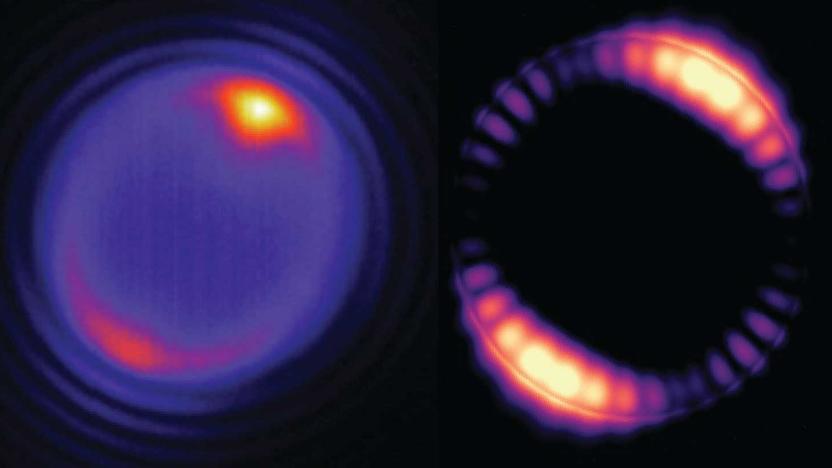berkeley
Latest

ChatGPT is suddenly everywhere. Are we ready?
OpenAI's startlingly realistic AI, ChatGPT, is seemingly everywhere these days -- optimizing our search results, impersonating celebrities, and leaving scathing Yelp reviews on our behalf. Are we, as a society, ready for all that?

YouTube's tweaks to recommend fewer conspiracy videos seem to be working
One of the most important aspects of YouTube is its recommendation engine, as the vast majority of views and watch time come from suggested content, rather than direct traffic. The platform does a good job of determining which videos would be relevant to a given user, but when it comes to news and fact-based videos, conspiracy theory content can find its way in. As of January of 2019 -- and after facing public backlash -- YouTube promised to curb the amount of conspiracy videos it pushes to users. A study published by the University of California, Berkeley states that these efforts do seem to be working, and that their analyses show a 40% reduction in the likelihood of YouTube suggesting conspiracy-based content.

Amazon opens its second '4-star' store in Colorado
Amazon isn't wasting too much time in expanding its 4-star brick-and-mortar concept, as it opened a second location in Lone Tree, near Denver, Colorado on Thursday. It follows the first store, which launched in Manhattan in September, and the company will soon open another in Berkeley, California.

New solar cell generates hydrogen and electricity at the same time
In the ongoing pursuit of abundant, renewable alternatives to fossil fuels, scientists have produced hydrogen for fuel cells through artificial photosynthesis, which splits water into hydrogen and oxygen. Traditional processes have struggled to use optical, electronic and chemical properties in a way that makes this method efficient, but now researchers from Berkeley Lab have created a recipe that could completely bypass the limitations in current materials.

DNA synthesis breakthrough could lead to faster medical discoveries
For all of the advancements in genetic research, DNA synthesis hasn't changed much in over four decades. That could make it a serious obstacle to scientists who are otherwise racing to develop a new drug or understand the human body. It might finally catch up to modern technology, however. A group at the Berkeley-based BioEnergy Institute have devised a synthesis technique that promises to be faster, more accurate and affordable. If all goes smoothly, it could significantly accelerate the pace of medical and biochemical discoveries.

Cell-sized 'microlasers' could regulate brain activity
Scientists have spent years creating ever-smaller lasers. Berkeley Lab's latest invention, however, is something special -- and could lead to a significant change in medicine. An international team at the school has developed "microlasers" that are smaller than a red blood cell. The researchers discovered that 5 micron-wide polymer beads mixed with exotic nanoparticles (sodium yttrium fluoride infused with thulium) could reliably emit bright light on specific wavelengths when exposed to infrared light. The concoction makes light bounce around the inner surface of the bead, creating collisions that can repeatedly amplify the light -- it's similar to the "whispering gallery" effect that lets you hear a quiet sound across a giant space with the right acoustics.

ICYMI: This rock-armored insect could change medicine
try{document.getElementById("aol-cms-player-1").style.display="none";}catch(e){}Today on In Case You Missed It: Researchers at the University of California, Berkeley discovered that an insect called the caddisfly spins strong, stretchy silk that works like a biological sticky tape. The caddisfly uses it to attach stones to its body to protect it underwater; humans are more interested in the fact that the waterproof adhesive might have medical applications. The publication Deep Look made a great video of the bug's underwater life that's worth a full watch if you're interested.

This is what it looks like when a neural net colorizes photos
We've seen the horrific results of Google's servers taking acid and interpreting photos with DeepDream, but what happens when a neural network does something altogether less terrifying with snapshots? It'll go all Ted Turner and colorize black and white images with what it thinks are the right chroma values based on analyzing countless similar photos. At least that's what a team of University of California at Berkeley researchers experimented with in their paper Colorful Image Colorization (PDF).

ICYMI: VR yourself into a robot, plasma physics and more
#fivemin-widget-blogsmith-image-399402{display:none;} .cke_show_borders #fivemin-widget-blogsmith-image-399402, #postcontentcontainer #fivemin-widget-blogsmith-image-399402{width:570px;display:block;} try{document.getElementById("fivemin-widget-blogsmith-image-399402").style.display="none";}catch(e){}Today on In Case You Missed It: UC Berkeley is using VR, motion capture and spatial mapping to put a human 'into' the body of a robot with a technique called robotic teleoperation. The video looks like a complicated form of the claw game, but also gives a really interesting perspective.

ICYMI: Smart sweat detector, AI for gaming and more
#fivemin-widget-blogsmith-image-261450{display:none;} .cke_show_borders #fivemin-widget-blogsmith-image-261450, #postcontentcontainer #fivemin-widget-blogsmith-image-261450{width:570px;display:block;} try{document.getElementById("fivemin-widget-blogsmith-image-261450").style.display="none";}catch(e){}Today on In Case You Missed It: Berkeley researchers developed a wearable sensor that can track the chemicals inside your sweat. The idea is that it can help identify dehydration, muscle fatigue and stress, though it could also help spot disease flare-ups for the diabetic.

#ICYMI: A cockroach robot, new half-boat drones and more
#fivemin-widget-blogsmith-image-53482{display:none;} .cke_show_borders #fivemin-widget-blogsmith-image-53482, #postcontentcontainer #fivemin-widget-blogsmith-image-53482{width:570px;display:block;} try{document.getElementById("fivemin-widget-blogsmith-image-53482").style.display="none";}catch(e){}Today on In Case You Missed It: The tiny robot that's modeled after cockroaches because science is disgusting; the family-friendly tech gadget to teach your two-year-old to call her grandma, if only you didn't have to install the corresponding app on your Mom's phone; and Parrot's new drones include a hydrofoil option, for the sailors who know how cool that is. (If you don't, check out this physics explainer for how a hydrofoil gives speed and rad points.)

Scientists turn an iPhone into a blood parasite detector
Seeing a hematologist is a luxury that few people can afford in the poorest parts of Africa. That's why a team at UC Berkeley has adapted its iPhone microscope project to identify blood parasites in under three minutes. CellScope Loa is, essentially, a 3D-printed box that a smartphone can sit on top of, taking five-second videos of blood samples. The companion app then looks for signs of movement from the microscopic worms that, when left untreated, cause river blindness and elephantiasis.

Berkeley's artificial photosynthesis turns carbon dioxide into future fuel
Whenever a scientific discovery claims to have solved one of the world's most critical issues, it's hard not to get a little bit excited. Today, our hopes are riding high on the news that Berkeley University might have just worked out how to solve the problem of climate change. Working in collaboration with the Department of Energy and the University of California, researchers have developed a system that captures carbon dioxide and turns it into chemicals that can be used to make plastics, drugs and, even better, biofuel.

Scientists can make your inner monologue audible
When you hear someone else speak, specific neurons in your brain fire. Brian Pasley and a bunch of his colleagues discovered this at the University of California, Berkeley. And not only that, but those neurons all appeared to be tuned to specific sound frequencies. So, Pasley had a thought: "If you're reading text in a newspaper or a book, you hear a voice in your own head," so why can't we decode that internal voice simply by monitoring brain activity. It's similar to the idea that led to the creation of BrainPort, which lets you "see" with your tongue. Your eyes, ears or vocal chords don't really do the heavy lifting, it's your brain. And if you can give the brain another source of input or output you might be able to train it to approximate a lost ability like speech.

Experimental display lets glasses wearers ditch the specs
Engadgeteers spend a lot of their day staring at a screen, so it's no surprise that nearly all of us are blind without glasses or contact lenses. But wouldn't it be great if we could give our eyes a break and just stare at the screen without the aid of corrective lenses? That's the idea behind an experimental display that automatically adjusts itself to compensate for your lack of ocular prowess, enabling you to sit back and relax without eyewear. It works by placing a light-filtering screen in front of a regular LCD display that breaks down the picture in such a way that, when it reaches your eye, the light rays are reconstructed as a sharp image. The prototype and lots more details about the method will be shown off at SIGGRAPH next month, after which, its creators, a team from Berkeley, MIT and Microsoft, plan to develop a version that'll work in the home and, further down the line, with more than one person at a time.

Science: Graphene headphones can beat your fancy cans
Feeling smug about those brand-name cans you just bought? A pair of researchers from Berkeley just made 'em obsolete with some Graphene. Conventional gear needs an oscillator that has to be damped down to produce a constant sound between 20Hz and 20kHz. Graphene, on the other hand, can be tailored to do the same job without any complicated, and power draining, over-engineering. Qin Zhou and Alex Zettl found their power-sipping setup to be as good, if not better than the pair of Sennheisers they tested it against. We're hopeful that Graphene headphones aren't too far away, assuming Fiddy doesn't get to the pair first and shut 'em down.

Daily Update for March 7, 2013
It's the TUAW Daily Update, your source for Apple news in a convenient audio format. You'll get all the top Apple stories of the day in three to five minutes for a quick review of what's happening in the Apple world. You can listen to today's Apple stories by clicking the inline player (requires Flash) or the non-Flash link below. To subscribe to the podcast for daily listening through iTunes, click here. No Flash? Click here to listen. Subscribe via RSS

Apple Store boosts revenues for entire shopping district
There's an old saying that "A rising tide lifts all boats," but nowhere has the truth of that saying been demonstrated more than in Berkeley, Calif., where the opening of the Fourth Street Apple Store in 2011 quadrupled sales tax revenues for the district in which the store is located. That quadrupling is just in the sales tax category in which the Apple Store is placed -- "furniture and appliances" -- but the impact of the opening is apparent even when all of the various categories are shown together. As pointed out on ifoAppleStore.com, it appears that the Apple Store was placed into that category specifically to disguise its contribution to overall tax revenues. The website did a quick calculation based on the revenue trend and determines that the store will probably have about US$38.4 million in sales for the first quarter of 2013, more than twice the per-store average for all Apple Stores. A PDF copy of the City of Berkeley economic report is available for viewing here.

Researchers use virus's rogue traits to create electricity from motion
Viruses are the swarming bullies of biology, but it turns out their alarming self-replication could one day power your iPod. We've seen them in batteries before, but researchers at Berkeley Labs have now coated electrodes with modified M13 bacteriophage, a harmless bacteria-eating virus, to create the first ever organic piezoelectric material -- which can convert force to electricity. The team explained that such a substance would be non-toxic, organize naturally into thin layers and self-regenerate, giving it a possible advantage over chemical options. In theory, by attaching a thin film of it to your shoes, power could be generated when walking, lending volts to the myriad electronics we pack around nowadays. To see a finger-powered video demo of our frequent-enemies making themselves useful for a change, stroll on past the break.

Apple's storefront design symmetry
Apple is known for its attention to detail, even in the smallest of things, and here's another example. ifoapplestore points to Apple's newly constructed 4th Street Store in Berkeley, California which is constructed to be symmetrical and aligned. The 76 centimeter stone tiles within the store are the focal point of this design. Both the store's windows panels and the sidewalk tiles outside the store are a multiple of this 76 cm dimension. It's a subtle design element that is pleasing to the eyes and may help draw traffic into the new retail store.











